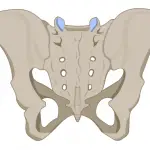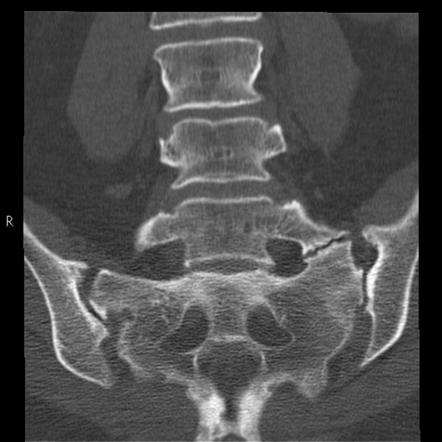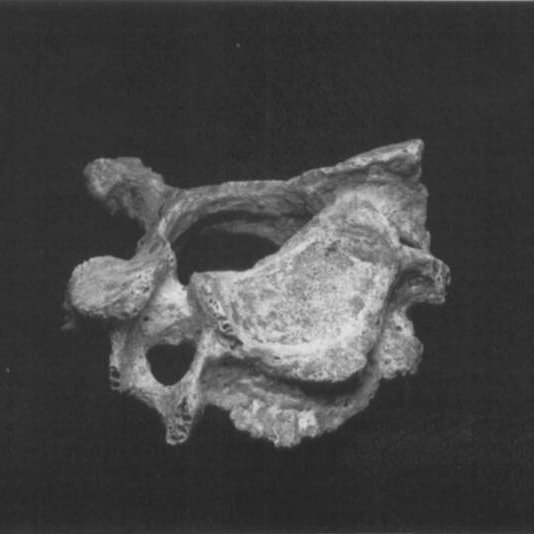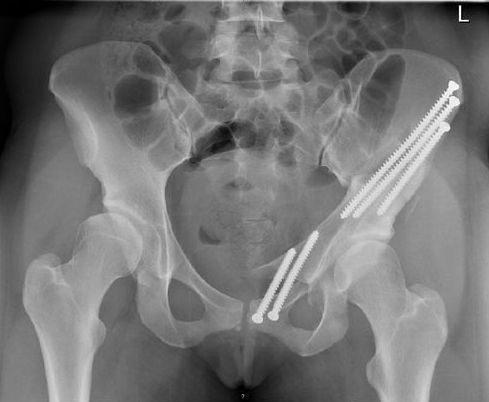Article reviewed and approved by Dr. Ibtissama Boukas, physician specializing in family medicine
Pelvic pain, often worrying, can be the symptom of a pathology or even a condition in itself.
What is pelvic pain, and what causes it? How to diagnose it? And above all, how to relieve it?
This article explains 6 causes of pelvic pain, in order to see more clearly and guide your care if you ever suffer from this condition.
Definition and anatomy of the pelvic region
Before discussing the causes of pelvic pain, it is worth reviewing certain notions of anatomy to better visualize this region of the body.
The pelvis, or pelvis, is the lower part of the trunk. It is located between the abdomen and the legs. This area supports the intestines, and also contains the bladder and reproductive organs.
On each side, there are two bones (femur) forming the hips. The joints are notably connected by ligaments and muscles. Together, the whole forms the pelvic girdle.
Each of the anatomical structures making up the pelvis can be the site of pathology. Before presenting the potential causes of pelvic pain, the next section will discuss the symptoms seen with n-level dysfunction.
Symptoms of the disease
Obviously, the main symptom felt will be pain. This can be constant or intermittent, dull or high-pitched.
In addition, it can be associated with:
- Abdominal cramps, bloating, diarrhea, constipation
- Discomfort during sex
- Discomfort during bowel movements or while urinating
- Symptoms made worse by certain positions (such as sitting or standing) and relieved by others (such as lying down)
- Worse on exertion (such as during walking, sports or running)
Depending on the signs and symptoms observed, the doctor will be able to make a diagnosis which will guide the management.
When to worry
Before presenting the possible causes of pelvic pain, it should be understood that some conditions are more serious than others.
Indeed, in some rare cases, pelvic pain may be due to a serious condition that constitutes a medical (and sometimes surgical) emergency.
It is imperative to consult urgently if you feel or observe the following signs:
- Constant pain that persists despite rest
- Nausea and/or vomiting
- Night sweats
- Fever
- Bleeding in the stool or urine
- dizziness
- Sudden pain that escalates quickly
- Change in skin color
- Inability to have a bowel movement or pass gas.
- Incontinence
Causes of pelvic pain
Many wonder where their pelvic pain is coming from. It should be understood that this is a complex condition with several potential causes. Sometimes the pain can result from one of the following conditions:
1. Gynecological conditions
- Adenomyosis
- Pregnancy-related disorders (such as an ectopic pregnancy)
- Endometriosis
- Menstrual cramps (dysmenorrhea)
- Miscarriage
- Ovarian tumors or cysts
- Uterine fibroids
- Vulvodynia
- Sexually transmitted diseases
- Presence of an IUD
2. Urinary conditions
- Interstitial cystitis
- Kidney stone (kidney stone)
- Urinary infection
3. Musculoskeletal conditions
- Low back pain
- Herniated disc
- fibromyalgia
- Pelvic muscle spasms
4. Inflammatory conditions
- Appendicitis
- Diverticulitis
- Pelvic inflammatory disease
5. Disorders of the digestive system
- Colon Cancer
- Constipation
- Crohn's disease
- Inguinal hernia
- Intestinal obstruction
- irritable bowel syndrome
- Ulcerative colitis
6. Psychological conditions
- Stress and anxiety
- Sexual abuse history
Pelvic pain in men
Pelvic pain mainly affects women. But the presence of this condition in humans should not be underestimated.
Indeed, although it cannot be linked to the female reproductive system, pelvic pain in men can still be caused by the other causes mentioned.
Also, any pathology or inflammation of the prostate can manifest as pelvic pain in men.
As with women, men with pelvic pain experience discomfort in the lower abdomen, hips, testicles and/or groin, either unilaterally or bilaterally. The pain may be located in the penis, and worsen during urination and ejaculation.
Diagnostic
Although common, pelvic pain is not easily diagnosed. This is due to the many causes that flow from it, as well as the fluctuating nature of pain.
Early diagnosis is important because it is common to observe pelvic pain that persists over time. We also consider chronic pelvic pain when it persists for more than 6 months.
A doctor will often begin their examination with a questionnaire aimed at identifying your symptoms. He will ask questions like:
- In what context did the pelvic pain appear?
- Where is the pain, and how do you describe it?
- How long does pelvic pain last when it appears?
- Is pelvic pain related to your menstrual cycle, urination and/or sexual activity?
Once the clinical examination is completed, he may prescribe other tests such as a blood test, a pregnancy test, a stool or urine sample, etc.
Furthermore, reviews ofmedical imaging may be requested to clarify the diagnosis. This may include an ultrasound, scanner, MRI, colonoscopy, hysteroscopy, etc.
How to relieve pelvic pain?
Once the cause of pelvic pain has been determined, the next step is to employ treatment strategies aimed at relieving the pain, and correcting the source of the problem.
Here are some modalities used to treat pelvic pain:
Rest and warmth
In cases where pelvic pain is temporary and mild (for example, during menstruation), rest is usually sufficient to relieve symptoms.
For example, heat can be used on the abdominal or pelvic region to relax muscles and soothe pain.
Medication
Of course, there are many medications available to relieve pelvic pain. On the other hand, it is necessary at all costs to identify the cause, otherwise the symptoms would be masked without treating the source of the problem.
For example, prescribing painkillers for a UTI requiring antibiotics would not treat your condition, and could make the pain worse in the long run.
A doctor will be able to prescribe the right medications for you based on your condition.
Diet change
When pelvic pain stems from damage to the digestive system, a change in diet can sometimes relieve the symptoms.
Some people cut gluten, others reduce their sugar intake. It is also possible to opt for a anti-inflammatory diet.
A qualified doctor or nutritionist will be able to guide you if your pelvic pain could be relieved by dietary modifications.
Natural treatments
Although there is no convincing scientific evidence related to alternative treatments, many people use natural therapies to relieve their pelvic pain:
- acupuncture
- acupressure mat
- suction cup (cupping therapy)
- myotherapy
- Quinton plasma
- percutaneous hydrotomy
- therapeutic yoga
- craniosacral therapy
- homeopathy
- sophrologie
It is important to inform your doctor if you ever have recourse to natural products. This will prevent potentially harmful interactions with other medications.
Natural products and home remedies
Again, although they are not supported by solid scientific evidence, several natural products and home remedies are used to treat pelvic pain, particularly for their anti-inflammatory power. It is essential to consult a doctor beforehand, mainly to avoid drug interactions and side effects.
Here is a non-exhaustive list of plants and essential oils that are effective in controlling pain and inflammation. The products are available on the site Country. Use promo code LOMBAFIT15 if you wish to obtain one of the following products, or any remedy aimed at relieving your symptoms and improving your quality of life:
- Turmeric. Thanks to its antioxidant and anti-inflammatory powers very powerful, turmeric is one of the most used plants in a culinary and therapeutic context. The composition of turmeric is essentially made of essential oils, vitamins (B1, B2, B6, C, E, K) and trace elements. But it is to its composition rich in curcumin and curcuminoids that we owe them and calm skin of this spice.
- Ginger. In addition to the special flavor it brings to the kitchen and its aphrodisiac properties, ginger is a root well known for its anti-inflammatory powers. the gingerol gives it its anti-inflammatory action. It is an active component acting on the inflammatory pain related to chronic joint inflammatory diseases, including rheumatoid arthritis, lupus, rheumatic diseases, etc. It has been proven that this active element is also effective in acting on the inflammation linked to arthritis and sciatica. Ginger also has other benefits thanks to its high potassium content and its richness in trace elements (calcium, magnesium, phosphorus, sodium) and vitamins (provitamin and vitamin B9).
- Omega-3s. Omega-3s are polyunsaturated fatty acids that play a very important role in the functioning of our body. They are provided by food in three natural forms: docosahexaenoic acid (DHA), alpha linolenic acid (ALA) and eicosapentaenoic acid (EPA). Beyond their action on the brain and the cardiovascular system, omega-3s prove very effective against inflammation. Indeed, they have the ability to act on the inflammatory mechanisms in osteoarthritis by slowing down cartilage destruction, thus they reduce the intensity of osteoarthritis pain. Sciatica, being most often linked to an inflammation secondary to a herniated disc, it can also respond to omega-3 provided it is consumed regularly.
- Lemon eucalyptus. Eucalyptus is a plant most often used in the form of herbal tea or essential oil. She would have anti-inflammatory effects which give it the ability to act on the bone and joint pain in general and the pain of sciatica in particular.
- wintergreen. Wintergreen is a shrub from which a very interesting essential oil is extracted. It is one of the most used essential oils in aromatherapy. This oil extracted from the shrub bearing the same name, is used in massage to relieve sciatica and act like a analgesic. Indeed, it provides a heating effect thanks to its ability toactivate blood circulation locally.
Remember that these products do not replace medical treatment. Do not hesitate to consult for support adapted to your condition.
Tools and accessories
In addition to the treatments mentioned above, there are several products and accessories available on the market to relieve pelvic pain of mechanical origin. It should be remembered that these tools usually provide temporary relief, do not address the source of the problem, and should therefore be used sparingly.
Among the products recommended by our professionals, we have:
- acupressure mat
- Heated lumbar belt
- Ergonomic back cushion
- massage gun
- Dorsal stretcher
- Spinal decompression table
Obviously, it must be understood that these tools will be of no use if the cause of the pain is of gynecological, urinary, digestive or simply non-mechanical origin.
Physiotherapy and Osteopathy
In cases where the pelvic pain is mechanical, physiotherapy exercises are often prescribed to soften the muscles concerned, and tone the abdominal and back region.
For example, kegel exercises are often prescribed to work the pelvic floor. Work on the psoas also helps reduce symptoms and improve function.
Stress management
If pelvic pain is associated with anxiety, it may be worth finding stress management techniques. For example, techniques of meditation ou breathing have proven useful for many people.
In some cases where depression is present, see a health care professional (such as a psychiatrist or psychologist) may be relevant.
surgery
In some cases, surgery may be needed to correct the cause of pelvic pain.
This can range from a small surgical correction to hysterectomy (removal of the uterus).
Obviously, an accurate diagnosis will be made beforehand, and the surgeon will have assessed the risks and benefits before proceeding with the operation.
Conclusion
There are several causes that can explain pelvic pain. Early diagnosis is essential to avoid complications, and the chronicization of the condition.
A health professional will be able to guide you if you suffer from pelvic pain, and offer the appropriate treatments.
Good recovery !











